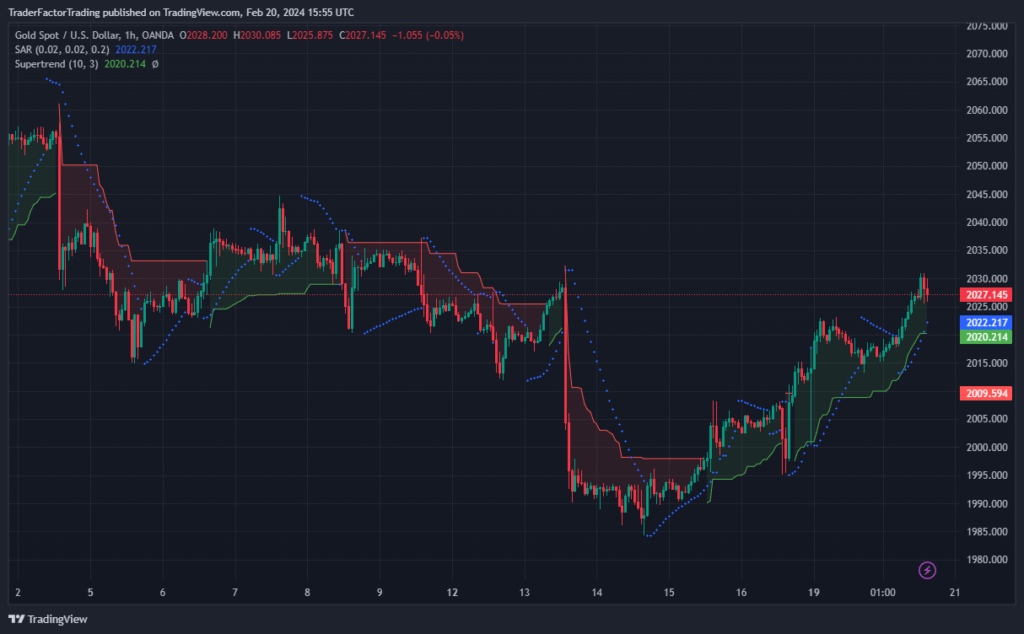Gold continues its bullish run, rising to the $2,030 zone on Tuesday after concluding positively on Monday. The 10-year US Treasury bond yield is lingering below 4.3%, facilitating XAU/USD to push its uptrend.
The Gold price (XAU/USD) is carrying forward its bullish streak for the fourth consecutive trading session on Tuesday. The precious metal’s outlook has been bolstered as comments from Federal Reserve (Fed) policymakers indicating inflation is generally moving in the desired direction have diminished the stubborn Consumer Price Index (CPI) and Producer Price Index (PPI) data for January’s effect.
XAUUSD DAILY CHART

AUD/USD Recovers Intraday Losses and Extends Gains
The Australian Dollar (AUD) has managed to rebound from its intraday losses, extending its winning streak for the fifth consecutive session on Tuesday. The United States Dollar (USD) saw a decline in its daily gains due to lower US Treasury yields, providing upward support for the AUD/USD pair.
However, the Australian currency faced some headwinds from a weakened domestic money market. The S&P/ASX 200 index put an end to its winning streak, with mining and energy stocks taking a hit due to falling commodity prices.
The Impact of the Reserve Bank of Australia’s Minutes on the AUD
Interestingly, the Australian Dollar didn’t show any significant reaction to the minutes from the Reserve Bank of Australia’s (RBA) February monetary policy meeting. The RBA board discussed the potential for a 25 basis point rate hike or maintaining the current rates.
While the data provided the board with increased confidence that inflation would revert to the target within a reasonable timeframe, they acknowledged it would take time before they could have sufficient confidence in the inflation outlook. As a result, the board agreed that it was appropriate not to discount the possibility of another rate hike.
The Influence of China’s Monetary Policy on the Australian Dollar
On another note, the People’s Bank of China (PBoC) kept its one-year Loan Prime Rate (LPR) steady at 3.45% but reduced the five-year LPR by 25 basis points. This move is expected to have a ripple effect on the Australian Dollar, considering the close economic ties between Australia and China.
The Anticipation of the FOMC Minutes
Investors are now awaiting the release of the Federal Open Market Committee (FOMC) minutes for further cues about the future direction of the AUD/USD pair. These minutes will provide insights into the US Federal Reserve’s views on economic conditions, financial markets, and monetary policy, which could potentially impact the Australian Dollar.
AUD/USD Intraday
The Australian Dollar (AUD) is currently under pressure against the US Dollar (USD), with an intraday downward trend that has seen it shed between 20 to 30 pips. As such, the recommendation for the AUD/USD pair in the spot market is a SELL order.
The entry price or pivot point stands at 0.6545. It’s advisable to set the target and take profit levels at 0.651 and 0.6500 respectively. To manage risk effectively, it’s recommended not to risk more than 2% per trade. This analysis is based on intraday trading conditions. Additionally, the Relative Strength Index (RSI) suggests a mixed to bearish sentiment, reinforcing the sell recommendation.

USD/CAD Recovers Above 1.3500 Amid Soft Canadian Inflation Data
The USD/CAD pair is on an upward trajectory as Statistics Canada has reported softer-than-expected inflation data for January. Contrary to investor expectations of a significant 0.4% rise, the monthly headline inflation remained steady. The inflation data contracted by 0.3% in December, while the annual headline inflation increased at a slower pace of 2.9%, falling short of the anticipated 3.3% and the previous reading of 3.4%.
Impact of Core Consumer Price Index on USD/CAD
The core Consumer Price Index (CPI) was released by the Bank of Canada (BoC). This index, which excludes volatile food and oil items, slowed down to 2.4% from 2.6% in December. On a monthly basis, the underlying inflation data saw a slight increase of 0.1% after deflating by 0.5% in December.
Implications of Slower Inflation Increase for BoC
The slower-than-expected increase in inflation data is likely to delay expectations for the BoC to keep interest rates at 5% for a longer period.
Market Mood and Federal Reserve’s Confidence
Meanwhile, the market sentiment remains positive as the Federal Reserve (Fed) maintains its confidence that inflation is declining towards the 2% mark, and the one-off increase in the January CPI data is deemed insignificant.
Varied Price Actions in Risk-perceived Assets
Investors are observing diverse price actions in risk-perceived assets. While the S&P500 futures have recorded significant losses in the European session, risk-sensitive currencies have been underpinned against the US Dollar. The US Dollar Index (DXY), which measures the value of the US Dollar against six major currencies, has hit a new five-day low near 104.00.
USD/CAD Intraday Trading Recommendation
For intraday trading, the USD/CAD pair exhibits a bullish bias above 1.3480, with an increase of 25-45 pips. The recommendation for this asset in the spot market is to BUY with an entry price (pivot) at 1.3480. The target and take profit levels are set at 1.3530 and 1.3550 respectively. As always, it’s prudent not to risk more than 2% per trade. The Relative Strength Index (RSI) indicates upside momentum, supporting the buy recommendation.

GBP Rises Against USD Amid Positive Market Sentiment
The Pound Sterling (GBP) has seen an uptick against the US Dollar in Tuesday’s European session. The market sentiment has become more positive as investors anticipate the release of the Federal Reserve Open Market Committee (FOMC) minutes, which will provide fresh insights into interest rates.
Influence of BoE’s Guidance on GBP
Further support for the Pound Sterling comes from the Bank of England (BoE) Governor, Andrew Bailey, and other policymakers who offered new guidance on interest rates during their testimony before the United Kingdom Parliament. This guidance has served as a temporary cushion for the GBP.
BoE Deputy Governor’s Remarks on Wage Growth and Inflation
BoE Deputy Governor Ben Broadbent highlighted that wage growth and services inflation are double the rate that would sustain inflation at 2%. However, he noted that the current monetary policy is sufficiently restrictive given the easing labor market tightness. Broadbent also mentioned that the central bank’s focus has shifted from the degree of restrictive monetary policy to its duration, but current evidence doesn’t support rate cuts at this stage. Regarding the timing of rate cuts, Broadbent emphasized that any adjustments would largely depend on actual economic data evolution. Policymaker Megan Greene also pointed out potential upside risks to wage growth.
BoE Governor’s Views on Price Pressures and Rate Cuts
In addition, Andrew Bailey indicated that there are encouraging signs of easing price pressures. He stated that market expectations of rate cuts this year are not unreasonable and suggested that rate cuts could be implemented even before inflation reaches the 2% target.
Warning About Downside Risks to UK Economy
Swati Dhingra, a BoE policymaker who voted for a rate cut in the last meeting, issued a warning about significant downside risks to the UK economy due to a tight monetary policy.
GBP/USD Intraday Trading Recommendation
For intraday trading, the GBP/USD pair is under pressure, dropping by 20-40 pips. The recommendation for this asset in the spot market is a SELL order with an entry price (pivot) set at 1.2610. The target and take profit levels are suggested at 1.2570 and 1.2550 respectively. It’s advised not to risk more than 2% per trade. The Relative Strength Index (RSI) is mixed to bearish, further supporting the sell recommendation.

EUR/USD Ascends Ahead of FOMC
The EUR/USD pair demonstrated an upward trend, breaching the 1.0800 mark on Tuesday due to the weakening demand for the US dollar. Trading conditions are stabilizing after the extended weekend in the United States, thereby boosting the pair’s recovery.
Despite the US Dollar maintaining its overall weakness, allowing the EUR/USD pair to hit a fresh three-week high of 1.0809 during the mid-European session, the Euro’s demand remains subdued. The currency pair continues to be confined within a tight intraday range.
Speculative interest is currently grappling with finding directional pointers following the realization that central banks will require more time to relax their monetary policies. The world’s policymakers have adopted a wait-and-see approach toward monetary policy, even though the reasons behind their decisions vary.
GBP/USD Makes Headway to 1.2650 Amid USD Weakness
The GBP/USD pair gained ground and escalated to the 1.2650 area following a calm Asian session on Tuesday. The USD’s renewed weakness, coupled with retreating US Treasury bond yields in the lead-up to Treasury note auctions, is aiding the pair’s upward push.
After a slight increase during the European trading hours, GBP/USD lost its momentum and ended the first day of the week near 1.2600, remaining relatively flat. The pair started Tuesday on the defensive, trading slightly below this level.
Bank of England (BoE) Governor Andrew Bailey, Deputy Governor Ben Broadbent, and Monetary Policy Committee (MPC) members Swati Dhingra and Megan Greene are set to testify before the UK Treasury Select Committee starting at 10:15 GMT on Tuesday.
Disclaimer:
All information has been prepared by TraderFactor or partners. The information does not contain a record of TraderFactor or partner’s prices or an offer of or solicitation for a transaction in any financial instrument. No representation or warranty is given as to the accuracy or completeness of this information. Any material provided does not have regard to the specific investment objective and financial situation of any person who may read it. Past performance is not a reliable indicator of future performance.
Author
-

Phyllis Wangui is a Financial Analyst and News Editor with qualifications in accounting and economics. She has over 20 years of banking and accounting experience, during which she has gained extensive knowledge of the forex, stock news, stock market, forex analysis, cryptos and foreign exchange industries. Phyllis is an avid commentator on these topics and loves to share her insights with others through financial publications and social media platforms.
View all posts



















